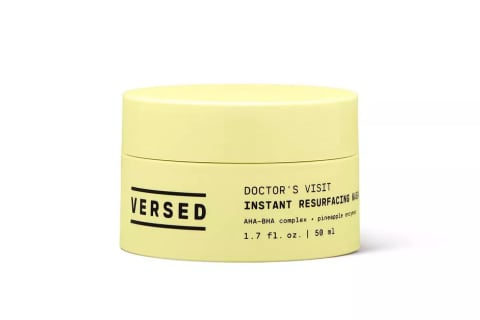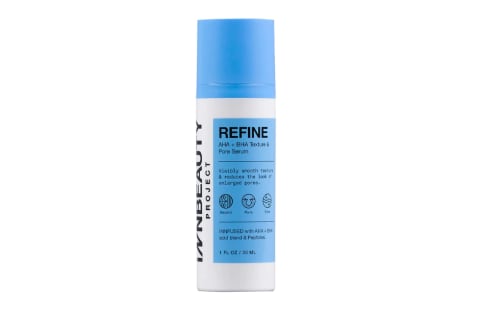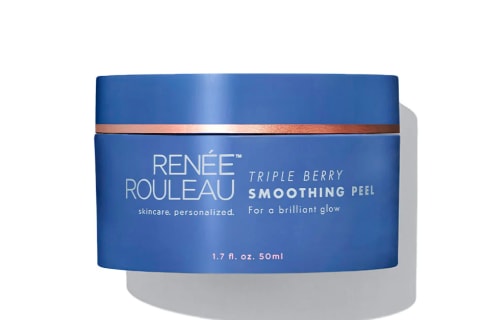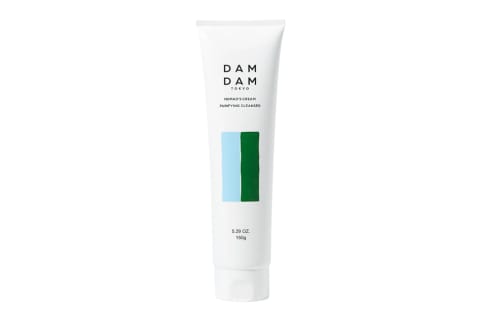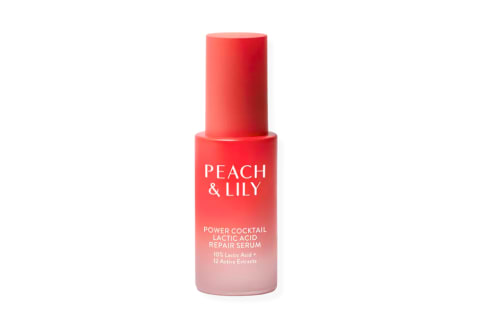AHA vs BHA: How To Find The One For You + Best Products


Adding just one exfoliant to your skin care routine can result in a long list of benefits: a brighter complexion, softened texture, fewer breakouts, and even softer fine lines and wrinkles. But just as your moisturizer and face wash should be personalized to your skin's needs, as is with this step.
Exfoliants come in two types: Physical and chemical. The former consists of abrasive skin care products (i.e. scrubs) or devices (brushes or rough pads). If you opt for chemical exfoliation, you'll have two main categories to choose from: AHAs and BHAs. To come, the difference between these two exfoliators and which one you should choose based on your skin type and skin goals.
What are BHAs?
Beta-hydroxy acids1 are chemicals that are oil- and fat-loving. "These are really good at breaking through oil and sebaceous skin," says board-certified dermatologist Mona Gohara, M.D.
Salicylic acid is the most common BHA, particularly known for its role in easing breakouts2, due to its ability to unclog pores. "It is able to penetrate the skin deeper into pores to help remove dead skin cells, fight bacteria, and control excess sebum," says board-certified dermatologist Zenovia Gabriel, M.D.
As she notes, salicylic acid is also found to be antibacterial, making it particularly effective for acne-prone individuals, as it not only dissolves excess oil, but it targets the acne-causing bacteria building up in the pores. These exfoliating acids are also great at smoothing out the rough, bumpy skin associated with keratosis pilaris.
Examples of BHAs
Salicylic acid is certainly the most popular BHA, but it's not the only one.
- Salicylic acid
- Tropic acid3
- Trethocanic acid
- Natural forms like willow bark extract and betaine salicylate, a BHA derived from beets
Benefits of BHAs
BHAs do more for your skin than just exfoliate, too. Below, a few benefits to note:
Reduces oil
Salicylic acid has been shown to regulate oil production4, one key factor for easing acne breakouts and excess shine.
Treats acne
Salicylic acid and acne go together like peanut butter and jelly. Salicylic acid is antimicrobial, and according to board-certified dermatologist Karan Lal, M.D., it can go deep into your pores and break open closed comedones (again, since the BHA is oil-soluble). This also helps to reduce the appearance of that pesky acne-induced hyperpigmentation.
Exfoliation
Then you have the obvious benefit: a smoother complexion. Unlike physical scrubs, BHAs and AHAs work to reveal smoother skin over time, so be patient if you don't see ideal results after just one use.
Help products penetrate
One of the most important benefits of regular exfoliation, be it with BHAs, AHAs, or manual scrubbing products, is this: Once the dead skin is gone, your other serums and moisturizers can penetrate deeper into the skin (i.e., work better).
Usage tips for BHAs:
- Start slow: Adding any kind of exfoliant to your routine should be done slowly. Don't use your new product every single evening. Instead, try adding it once or twice a week and building up to a more regular cadence if needed.
- Sensitive skin be wary: These ingredients tend to be a tad stronger than AHAs, which is why they're not normally recommended for those with sensitive skin unless you have sensitive skin and breakouts. Even then, you may want to opt for a gentle salicylic acid product (read: less than 2% SA) or use it in a wash-off cleanser or mask.
- Always wear SPF: Regular exfoliation makes your skin more prone to burn and sun damage, so be sure to always wear and reapply SPF as needed.
- It shouldn't burn: If you begin using a BHA product and it leaves your skin red, itchy, or irritated, then it's not the right one for you. Opt for something more gentle or an AHA instead.
Shop BHA products
What are AHAs?
"Alpha-hydroxy acids are water-soluble, meaning they mingle well with water and remain superficial on the skin surface," board-certified dermatologist Brendan Camp, M.D., FAAD, tells mbg. These are great for anyone with sensitive skin looking for gentle exfoliation and some healthy skin aging effects, Camp notes.
These ingredients can be found in cleansers, serums, masks, and even moisturizers. They vary in strength, with products designed for sensitive skin containing a less potent dose of AHAs than those formulated for normal or oily skin types.
Examples of AHAs
There are many more commonly used AHAs than there are BHAs, so here's a quick explanation of a few key players:
- Glycolic acid: Glycolic acid has the smallest molecular weight of all the alpha-hydroxy acids, which means it can penetrate the outer layer quite easily (unlike its AHA counterpart, lactic acid, which is larger in molecular size). It's best known for its ability to ease acne scars and hyperpigmentation all while thickening the skin5 and making it more plump.
- Lactic acid: This acid is derived from milk (though you can find vegan options) and is found in professional and over-the-counter peel products. Lactic acid has one of the larger molecules in the group, which means it can't penetrate as deeply as others. This means all of the hard work of the acid happens on the surface of the skin, which decreases the amount of irritation and helps to protect the skin barrier.
- Mandelic acid: While glycolic and lactic acid may be the most popular, mandelic acid is earning its spot in skin care products everywhere. This acid molecule is even larger than lactic acid, meaning it's more gentle as well. Plus, it can regulate excess oil production6, providing BHA-like benefits without the irritation for those with sensitive skin types.
Benefits of AHAs
Each AHA has its own unique profile, but there are a few overarching benefits when it comes to AHAs:
Brightening
If you're looking to treat dark spots or just brighten your complexion, AHAs can help7. More specifically, a skin care regimen containing mandelic acid and vitamin C was associated with a 73% improvement in the appearance of post-inflammatory hyperpigmentation and melasma8.
Exfoliating
Like BHAs and physical scrubs, AHAs help to slough off dead skin cells to reveal a fresh layer of skin. Once this happens, your skin will feel smoother and your other skin care products will be able to reach deeper into your skin.
Can be hydrating
Some AHAs can even be hydrating for the skin7, which is why they're generally advised for anyone with dry skin (rather than their BHA cousins). Lactic acid9 is especially good in this department.
May ease fine lines
Research even notes that AHAs can help ease fine lines and wrinkles7. While you won't want to combine this ingredient with some other healthy aging product like retinol, it can be used in the same routine on different nights or in the morning.
Usage tips for AHAs:
- Pay attention to concentration: Just like with BHAs, higher concentrations of AHAs may be irritating for those with sensitive skin.
- Don't mix with retinol: This one goes for any exfoliant: Don't use it at the same time you use retinol. If you mix the two ingredients, your skin will become irritated and you could risk damaging your skin barrier.
- Work your way up: If you're nervous about adding AHAs to your routine, start with a mandelic acid product and work your way up to something like glycolic acid if you see fit.
- Always wear SPF: As mentioned above, exfoliants make your skin more susceptible to burn and sun damage, so always wear SPF and apply regularly if you're spending time in the sun.
Shop AHA products
Differences between AHAs and BHAs
While we've outlined this info above, a here's a general recap of what makes AHAs and BHAs different.
- AHAs are alpha hydroxy acids. BHAs are beta hydroxy acids.
- AHAs are water-soluble. BHAs are lipophilic, meaning oil- and fat-soluble.
- AHAs tend to work on the surface of the skin. BHAs are able to penetrate deeper into the pores.
- AHAs can also be hydrating, which makes them better suited for dry and sensitive skin. BHAs can help treat acne, and are better for those with breakout- and oil-prone skin.
How to combine them
Should you mix both AHAs and BHAs? Not exactly. "Don't DIY your acid combination," board-certified dermatologist and mindbodygreen Collective member Whitney Bowe, M.D., FAAD, warned. "The acids need to be formulated in a way that makes them stable together." Read: Don't layer an AHA over a BHA—look for a product that has them both, or pick one.
As a general guideline, those with acne or excess oil should opt for BHAs. Those looking for other benefits like smoothing texture, brightening the skin, or easing fine lines should start with AHAs.
In addition, anyone with sensitive or highly reactive skin should look for a gentle AHA product, preferably one packed with other hydrating ingredients like hyaluronic acid, peptides, ceramides, etc.
Or, you can rotate them. "If someone wants to use a more gentle AHA every day but then use a BHA when they're breaking out, they certainly can do that," Gohara notes.
How to use BHAs and AHAs in your routine
Like with any skin care product, you'll want to create a designated spot for these exfoliators. Everyone follows different regimens, but here are a few must-know tips to keep in mind:
- Don't mix with retinol: Mixing AHAs or BHAs with retinol can increase the risk of irritation and redness. Instead, use them on different nights (like skin cycling).
- A cleanser counts: If you're using a cleanser with AHAs, BHAs, or physical exfoliant beads, then you don't need to use a serum with the same actives on the same night.
- Don't use twice daily: Unless instructed otherwise by a skin care professional, you don't need to use these ingredients twice in one day. If you do, you'll run the risk of making your skin more sensitive and irritated.
- Mind the purge: AHAs and BHAs can throw you into a skin purging period, when you may see an increase in breakouts. This shouldn't last more than a month or two, but remember that it's completely normal and a part of the process. If you want to learn more about skin purging, check out this guide.
Side effects and cautions
Exfoliation, in any form, can cause irritation. It's important to listen to your skin and stop using a chemical exfoliant when you notice redness, irritation, or sensitivity.
- Side effects of AHAs: As mentioned above, the main side effects of using AHAs include sensitivity, redness, irritation, and a higher susceptibility to sun damage 10and sunburn.
- Side effects of BHAs: BHAs pose similar risks and may be more irritating for those with sensitive skin. As the FDA recommends3, apply this product to a small area of your skin to patch test before making it a part of your routine, just to ensure your skin can handle it.
FAQ
What are AHAs and BHAs?
Alpha-hydroxy acids (AHAs) and beta-hydroxy acids (BHAs) are chemical exfoliants that help to slough off dead skin cells when applied topically. BHAs are generally recommended for those with acne or excess oiliness, while AHAs are better fit for anyone looking to brighten their complexion, ease fine lines and wrinkles, or smooth texture.
Can you use BHA and AHA together?
You should not mix separate AHA and BHA products together. These ingredients can be used in the same formula, but mixing preformulated products together at home is not recommended, as the formulas were not designed to mix and may be irritating to the skin. If you want to use both AHAs and BHAs, find a product that comes with both ingredients or use AHAs most of the time and BHAs when you're breaking out.
Is salicylic acid an AHA?
No, salicylic acid is not an AHA, or alpha-hydroxy acid. Instead, it falls into the BHA, or beta-hydroxy acid category.
The takeaway
Exfoliation can be a great step to add to your routine, but do so while noting your skin type and concerns. If you have oily skin or you're acne-prone, opt for BHAs. If you have sensitive skin or you're looking for improvements in brightness, texture, or fine lines, opt for AHAs. Still not sure how often you should be using them? Here's a bit more information on cadence to help you out.

Hannah Frye is the Assistant Beauty & Health Editor at mindbodygreen. She has a B.S. in journalism and a minor in women’s, gender, and queer studies from California Polytechnic State University, San Luis Obispo. Hannah has written across lifestyle sections including skin care, women’s health, mental health, sustainability, social media trends, and more. She previously interned for Almost 30, a top-rated health and wellness podcast. In her current role, Hannah reports on the latest beauty trends and innovations, women’s health research, brain health news, and plenty more.
10 Sources
- https://www.ncbi.nlm.nih.gov/pubmed/12460741
- https://www.ncbi.nlm.nih.gov/pmc/articles/PMC4554394/
- https://www.fda.gov/cosmetics/cosmetic-ingredients/beta-hydroxy-acids
- https://pubmed.ncbi.nlm.nih.gov/24641601/
- https://pubmed.ncbi.nlm.nih.gov/12839261/
- https://www.jaad.org/article/S0190-9622(20)31574-7/fulltext
- https://www.ncbi.nlm.nih.gov/pmc/articles/PMC3941867/#:~:text=The%20well%2Dknown%20benefits%20of,AHA%20compounds%2C%20extracted%20from%20sugar.
- https://pubmed.ncbi.nlm.nih.gov/23377327/
- https://pubmed.ncbi.nlm.nih.gov/19245467/
- https://www.fda.gov/cosmetics/cosmetic-ingredients/alpha-hydroxy-acids

